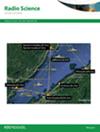A multi-objective optimization-based reflective metasurface for enhanced multi-point focusing with diffraction suppression
IF 1.6
4区 地球科学
Q3 ASTRONOMY & ASTROPHYSICS
引用次数: 0
Abstract
Metasurface arrays can achieve beam control at low cost and high quality by providing different phase compensations for each unit, effectively focusing microwave energy on target locations. With the development of short-range communication technology or microwave power transmission technology, the demand for focusing has also increased. Using metasurface arrays to achieve multi-target focusing has wide application value. However, as the number of focal points increases, the superposition of electromagnetic wave propagation paths leads to significant interference phenomena, which can impact potential applications. Existing solutions are unable to solve such complex problems involving a large number of targets with conflicts between them. Multi-objective algorithms, by iteratively obtaining a set of optimal solutions, provide decision support for designers in complex multi-objective problems. This paper alters the phase of cells in a reflective array, calculates the near-field electric field model using the Fresnel diffraction formula, and employs various solutions using the Non-dominated Sorting Genetic Algorithm III (NSGA-III) combined with different constraints. Finally, we select the balanced solution to establish the array. After simulation, three adjacent focal points with normalized central values of 1, 0.86, and 0.88 were obtained, with the maximum electric field value outside the focal points being only 0.58, demonstrating the feasibility of multi-objective algorithms in solving complex multi-focal problems.基于多目标优化的反射元面,用于增强多点聚焦并抑制衍射
元表面阵列可以通过为每个单元提供不同的相位补偿,实现低成本、高质量的波束控制,从而有效地将微波能量聚焦到目标位置。随着短程通信技术或微波功率传输技术的发展,对聚焦的要求也越来越高。利用元面阵列实现多目标聚焦具有广泛的应用价值。然而,随着聚焦点数量的增加,电磁波传播路径的叠加会导致严重的干扰现象,从而影响潜在的应用。现有的解决方案无法解决这种涉及大量目标且目标之间存在冲突的复杂问题。多目标算法通过迭代获得一组最优解,为设计人员解决复杂的多目标问题提供决策支持。本文改变了反射阵列中单元的相位,使用菲涅尔衍射公式计算了近场电场模型,并使用非支配排序遗传算法 III(NSGA-III)结合不同的约束条件采用了各种解决方案。最后,我们选择平衡解来建立阵列。经过仿真,得到了三个相邻的焦点,其归一化中心值分别为 1、0.86 和 0.88,焦点外的最大电场值仅为 0.58,证明了多目标算法在解决复杂的多焦点问题中的可行性。
本文章由计算机程序翻译,如有差异,请以英文原文为准。
求助全文
约1分钟内获得全文
求助全文
来源期刊

Radio Science
工程技术-地球化学与地球物理
CiteScore
3.30
自引率
12.50%
发文量
112
审稿时长
1 months
期刊介绍:
Radio Science (RDS) publishes original scientific contributions on radio-frequency electromagnetic-propagation and its applications. Contributions covering measurement, modelling, prediction and forecasting techniques pertinent to fields and waves - including antennas, signals and systems, the terrestrial and space environment and radio propagation problems in radio astronomy - are welcome. Contributions may address propagation through, interaction with, and remote sensing of structures, geophysical media, plasmas, and materials, as well as the application of radio frequency electromagnetic techniques to remote sensing of the Earth and other bodies in the solar system.
 求助内容:
求助内容: 应助结果提醒方式:
应助结果提醒方式:


